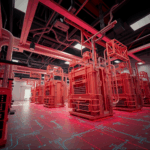
BIM vs CAD: Which Technology is Right for My Project?
As capital projects grow more complex, the tools we use to design, plan, and manage those projects will understandably evolve. The engineering challenges associated with data center construction, for example, require a higher level of data management and knowledge sharing than traditional solutions. This is just one example of many that demonstrate why the industry requires more advanced technologies.
Computer-aided design (CAD) and building information modeling (BIM), two pivotal solutions in the built environment space, each allow project stakeholders to extend their capabilities in design, review, and collaboration — reducing the chance for human error and giving all contributors greater visibility into project scope.
But which one is right for you?
What is Building Information Modeling (BIM)?
Building information modeling (BIM) software has become the new standard for design, documentation, and execution in the construction space. Why? Because it integrates extremely detailed building data with design elements, allowing architects, designers, engineers, and other consultants to create a fully digital, highly intelligent model of a project even before the planning phase is complete.
The right BIM solution can also help project leaders avoid a sadly common trend across modern construction: rework.
An estimated 30% of all construction work is rework — corrective work that helps fix errors or oversights, or changes in project scope. While some rework is inevitable, excess rework can easily lead to financial loss and compromise original project timelines. It also reduces productivity, strains relationships with stakeholders, and imposes additional safety concerns.
The accuracy of the right BIM solution can drastically reduce the risk if excess rework, which is one of many reasons BIM has become so popular in the industry. Here’s how it achieves this:
- Improved design accuracy: BIM allows for detailed and accurate 3D models, reducing the likelihood of errors and discrepancies in the design phase.
- Better collaboration: BIM facilitates better communication and collaboration among project teams, ensuring everyone is on the same page and reducing costly misunderstandings.
- Real-time updates: Building information models can be updated in real-time, ensuring that any changes are immediately reflected across all project documentation and plans.
- Lifecycle Management: BIM supports the entire lifecycle of the project, from design to construction to maintenance, ensuring that all phases are well-coordinated, aligned, and executed.
BIM services are continually utilized throughout the construction process, with users adjusting and revising models to maintain an exact, precise representation of the physical structure. This process helps protect the integrity of the building process and creates the most accurate, constructible version of a particular project.
What is BIM Commonly Used For?
Building information modeling has revolutionized the engineering, architecture, and construction (AEC) industry with a design-first approach to construction execution. As such, it has many applications, but here are the most common applications of BIM across a project:
- Design visualization: BIM creates detailed, accurate 3D visualizations of a project during the design phase. These visualizations allow architects and designers to experiment with different design options, materials, and layouts before finalizing the plans.
- Clash detection: BIM software can identify spatial conflicts between different building systems, such as structural elements, plumbing, electrical, and HVAC systems. By resolving these clashes in the design phase, BIM helps avoid costly rework and delays during construction.
- Documentation: BIM provides a comprehensive, centralized repository of all project documentation, including drawings, specifications, schedules, and cost estimates. This gives stakeholders access to the latest, most accurate information, reducing the chances of errors and discrepancies.
- Construction scheduling: A category of BIM, known as 4D BIM, allows you to maintain detailed construction schedules and sequences. This involves linking the 3D model with the project timeline to visualize the construction process over time.
- Cost estimation: BIM can be used for precise cost estimation and budgeting, often referred to as 5D BIM. By integrating cost data with the 3D model, BIM provides accurate and detailed cost estimates for materials, labor, and other expenses.
BIM can also be a critical tool for monitoring ecological initiatives across a project by enabling users to perform sustainability and energy efficiency analyses, which entails simulating various design scenarios and their impact on energy consumption. This helps architects and engineers design more sustainable, environmentally-friendly buildings without compromising design standards, financial parameters, or the project’s original timeline. As sustainability becomes a greater priority in construction, this will be increasingly important.
What is Computer-Aided Design (CAD)?
Computer-aided design (CAD) is a more traditional solution and refers to the process of using computer software to create 2D drawings of physical components. Unlike hand-drawn blueprints, 2D CAD drawings can be easily edited, scaled, and shared. This technology replaces manual drafting with an automated process, enhancing the accuracy, efficiency, and versatility of the design process.
What is CAD Commonly Used for?
CAD is used across most construction design projects because it provides a cost-saving option — providing simple drawings and a fast solution for high-level conceptual drawings.
Here’s how project leaders might use CAD across a worksite:
- Architectural plans: Architects use 2D CAD to create floor plans, elevations, sections, and detailed construction drawings. These plans provide a drawing set for builders and contractors to follow during the construction process.
- Engineering schematics: Engineers use 2D CAD to create technical schematics for electrical, mechanical, and plumbing systems. These drawings include detailed information about components, connections, and functions.
- Manufacturing drawings: When manufacturing elements for a project, designers can use 2D CAD to create drawings of parts and assemblies. These drawings guide the production process, ensuring that each component is manufactured to exact specifications.
While CAD represents a fast, affordable solution for simple designs, it cannot replace the efficiency of BIM for full-scale project coordination and there are key differences between these two solutions that contractors should be aware of.
BIM & CAD: Differences Contractors Need to Know
BIM and CAD are vastly unique solutions in the construction space. While both design solutions create digital plans of physical projects, they differ widely in capability and application.
CAD is primarily used for creating detailed 2D drawings. It is precise and fast, ideal for projects that require straightforward technical drawings and documentation. CAD allows architects to focus on the creative aspect of design, spending more time thinking and ideating rather than producing intricate drawings. For smaller projects or individual project aspects with less complexity or less coordination needed, CAD provides a cost-effective and efficient solution.
When those CAD designs become too complicated to translate the mind of an architect or when multiple complex disciplines need to be coordinated, BIM is the go-to solution. BIM designs surpass simple drawings by integrating various aspects of a building’s lifecycle into a single digital model and allows for a 3d coordination process. It combines design elements with intricate building data, allowing architects, engineers, and other consultants to create a robust, intelligent model of a project.
In short, BIM is the preferred solution for complex projects that require detailed planning, coordination, and management throughout the construction process. Because it also includes elements like sustainability analysis, cost planning, and resource allocation, BIM is perfect for projects with detailed planning, data integration, and collaboration requirements.
Which Solution is Better for My Project?
Computer-aided design is a suitable solution for 2D drawings. But for the growing prevalence of complex, large-scale projects, BIM is the best solution for digital modeling. Its capacity to handle comprehensive project data make it a virtual requirement for intricate construction. Particularly in the hands of the right BIM consulting team, building information modeling drives efficiency and a competitive advantage in the construction space that CAD simply can’t compete with.
Interested in BIM? Partner with a leading BIM service provider to give your next project the modeling capabilities it needs. Schedule a call with VIATechnik today to determine how BIM can translate digital designs into physical buildings, with your preferred outcomes in mind.



